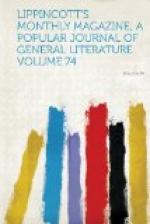The shearing-shed lay somewhat apart from the other ranch buildings, with a system of pens at its back, with chutes and swinging wickets for “cutting out” lambs from their mothers destined for the shears, and other incidental purposes. The shed was a roof of bearded mesquite-grass, stayed by boughs and supported on live-oak or pecan posts, the outside or bounding rows of which were sheathed up with boards four feet or so, the remainder space up to the roof being open for draught. On these boards Baleriano Torres, Secundino Ramon, and others their companions of the shears, who had worked and played beneath this shade in springs past, had written their names in large characters of stencil-ink. One could see in the county roofs made of fresh boughs, through which the sunlight sifted, flecking the swarthy faces and arms of the shearers and the mantles of the sheep with a very picturesque effect; but it is probably best to resist the temptation to treat the shearing-shed as an artistic composition. The ground-plan of the shed was one hundred feet or so long by twenty-five wide. The floor was of trampled earth, and on it were placed shearing-tables, s s s, and burring-and tying-tables, B B. The shearing-tables were about fifteen inches high, the burring-tables high enough for a man to stand up to. It is the custom in many parts of the country to shear on the floor. In Mr. Hardy’s picturesque novel, “Far from the Madding Crowd,” the shearers shear in a cathedral-like barn, on a shining black-oak floor,—probably for purposes of contrast. Round the ranch, however, shearers preferred very generally the low wooden tables. The space back of the shearing-tables was occupied, when shearing was going on, by a “bunch” of sheep admitted through the movable panels from a pen containing the unshorn: after shearing, they departed through the panels into another pen, and eventually over the prairie to their pleasant grazing-grounds, angular and grotesque in appearance, but happy, their troubles past, their year’s chief purpose served.
[Illustration: Movable Panels. CORRALS.]
The shearers this year were a band of forty or so Mexicans from Uvalde and other border towns, jollily travelling two hundred miles up the country in charge of a capitan and grande capitan responsible fellows, who had contracted with the ranchmen of the neighborhood to do their shearing. Early in May we heard of them on the creeks, and made preparation for them, the shed and corrals being put to rights




